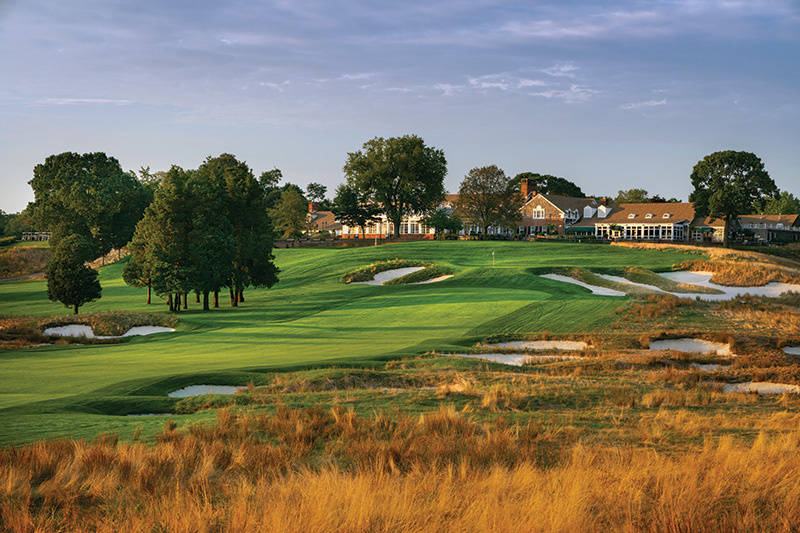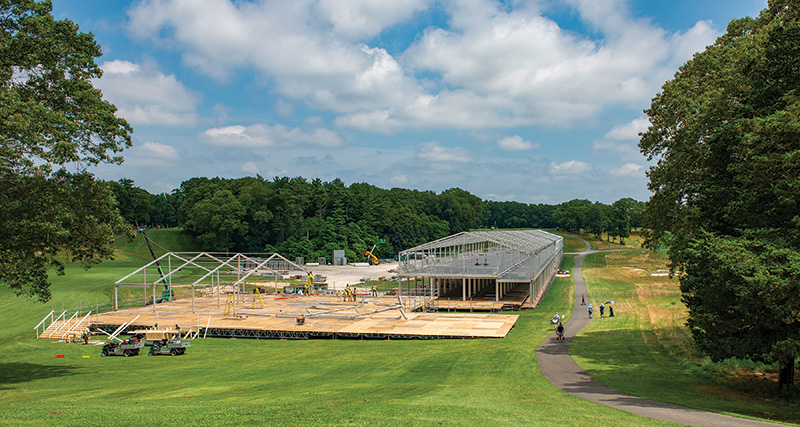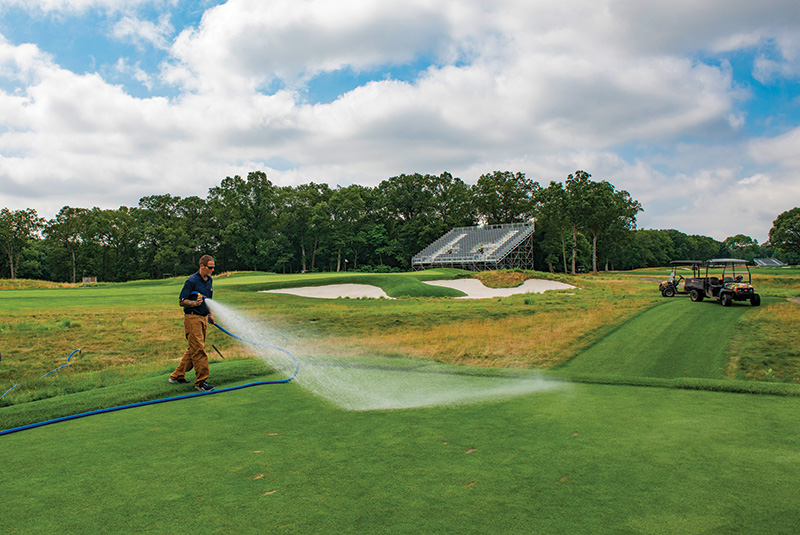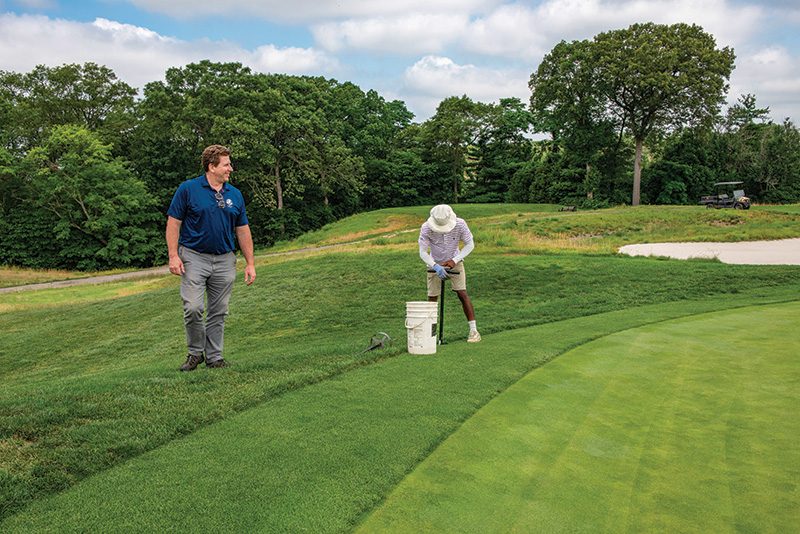
Bethpage State Park’s Black Course has hosted two U.S. Opens and a PGA Championship and, next month, will add a Ryder Cup. Photo courtesy of the PGA of America
Bethpage State Park’s Black Course has been the site of some of golf’s grandest spectacles.
In 2002, it became the first truly public course to host a U.S. Open, and it hosted another seven years later. In 2019, the course that’s so challenging it carries a warning label hosted the PGA Championship.
But this is a different beast.
Late next month, Bethpage Black in Farmingdale, N.Y., will host its first Ryder Cup, joining a select group of just three other courses that have turned that trifecta.
Darned right the staff there is fired up.
“The Ryder Cup is the biggest tournament in golf,” says Andrew Wilson, GCSAA Class A director of agronomy and 25-year association member. “This is the pinnacle of some of our careers. I’ve been here 35 years. Michael Hadley, our Black Course superintendent, has been here 25 years. We’ve had two U.S. Opens, a PGA Championship and now a Ryder Cup. It’s awesome.”
But if you think Wilson and his crew are feeling the heat, think again.
“There’s a lot of social media stuff, people who want their 15 minutes of content,” Wilson says. “But in terms of pressure … we want the golf course in the best shape it can be every day. With Mike and I having been here so long, it’s nice to hear the accolades. But we’ve also been around long enough, we know if we’ve done everything we could, that would be satisfaction enough.”

An early look at some of the massive infrastructure build-out that goes with hosting a Ryder Cup. Photos by Jim Krajicek
‘Summer doldrums’
Though Bethpage Black, which also hosted the Barclays PGA Tour event in 2012 and 2016, is no stranger to having served as golf’s biggest stage, this Ryder Cup — the hotly contested (and sometimes contentious) biennial international match-play competition — is a bit of an outlier.
Those U.S. Opens were contested in mid-June. Bethpage was a bit of a guinea pig in 2019 when it hosted the PGA Championship in mid-May. Prior to that year, the PGA Championship had been held in the swelter of August.
Even those Barclays e vents at Bethpage were high-summer events.
This year’s Ryder Cup, in contrast, will be held Sept. 26-28.
“Preparation for the PGA was more like, ‘Hopefully the grass is growing in May,’” says Hadley, a 27-year GCSAA member. “In the summer, you have a lot of problems that can pop up, like diseases and weeds, that make the season longer. You have to be a lot more vigilant.”
“It’s definitely easier preparing for the PGA Championship,” Wilson says. “There’s barely any traffic to recover from.”

Adrano Maragh (standing) and Dennis Giltz hard at work in the shop at Bethpage State Park in Farmingdale, N.Y.
That’s not the case this time of year.
Bethpage’s five courses see around 300,000 rounds annually. Despite the famous warning sign declaring itself appropriate only for “highly skilled golfers,” the Black Course still gets in excess of 30,000 rounds a season.
Still, as of mid-July and about a month before the course will be closed to outside play, Wilson says, “It’s not particularly beat up. Demand for play has been super high. This time of year, divots don’t recover well. It’s a cool-season-grass golf course. Those cool-season grasses aren’t germinating like they had been. It’s almost like things are a little tired this time of year, a little worn. Two weeks ago (in late June), we had one 101-degree day, days in the high-90s. That was unusual for us. For a cool-season-grass golf course, we’re sucking wind right how. We’re in the summer doldrums.”
To compensate, the course started restricting daily rounds, from about 240 around the Fourth of July down to 140. “Taking 100 golfers off the course helps,” Wilson says.
On Aug. 18, the course will be all but closed.
“We’ll still have a couple of PGA outings,” Wilson says. “A lot of it is still TBD — to be determined, like the practice rounds beforehand. But we’re figuring we’ll have about three weeks at least of the course being pretty much unplayed. That first day we close, we’ll get all the divots filled, all the ball marks filled and really take advantage those first few days we’re closed to set the wheels in motion.”

Tom Genovese hand-watering at Bethpage Black.
‘Perfect superintendent weather’
While the summer doldrums might not be ideal for preparing a cool-season course for the Ryder Cup, the subsequent September cooldown should be perfect for hosting it.
“The weather generally turns around September,” Wilson says. “We should be in good shape by the time the Ryder Cup rolls around. Usually, we have 75 for the high, 58 for the low that time of September — perfect superintendent weather.”
That said, a lot can happen climatically between mid-summer and late September, which is why Wilson says weather is his only potential worry. “Only because we can’t control it,” he says. “You know, it’s a pain to have employees dragging hoses around, but it’s better to be drier than wetter. It’s hard to take water away, and we’ve been lucky in that we haven’t had any really heavy thunderstorms. It’s humid as anything, but we’re lucky it’s been dry.
“The next month and a half we’ll be assessing if we have any areas we may need to seed and even fertilization strategies. Once the weather starts to get in our favor, we’ll determine what areas we want to prioritize.”
Curiously, the course might play a tad easier than usual. Based on conversations with the past two American Ryder Cup superintendents — at Whistling Straits (2021) and Hazeltine National Golf Club (2016) — Wilson and Hadley (the Black Course’s superintendent since 2013) — anticipate a shorter-than-normal rough. In fact, the rough could be trimmed even shorter than the 2 1⁄2-3 inches as it’s usually grown to for regular public play. Hadley says he’s anticipating it to be cut to a “thick but more playable” 2 1/4 inches, much shorter than the 4 inches of the U.S. Opens and PGA Championship.
“I guess from what we hear from the last two Ryder Cup superintendents, we might be mowing the rough tighter than for our other majors. We haven’t gotten that exact instruction, but we’re waiting for something like that,” Wilson says. “Not much, maybe half an inch. But we’re hedging our bets. Last year, we mowed it even lower to see when the time comes if we can go lower with the rough. We’re in the phase now where the rough is in a good spot. If we want to go ¼- or even ½-inch lower, we’re confident we can accommodate that.”

Andrew Wilson, Bethpage State Park’s longtime director of agronomy, left, says the Ryder Cup represents the “pinnacle” of his career.
Massive build-out
Wilson attended both past U.S. Ryder Cups, as well as the intervening 2023 edition at Marco Simone Golf and Country Club in Italy, so he’s quite familiar with the spectacle that goes along with it.
That’s not to say it doesn’t still awe him.
“They’re putting up a small village over here,” Wilson says. “No. ‘Small village’ doesn’t do it justice. It’s a small city going in, and they’re doing things on all five courses. It’s an enormous build-out. There’s going to be flooring on fairways, hospitality tents, concessions. They’re even using our polo fields for parking. Part of the Red Course will be used for helicopter landings. It’s pretty crazy. You might be in one area on Yellow, and you blink and you see half a merch tent has gone up.”
The Green Course also was restricting rounds and is being played as a 16-hole course, since its Nos. 1 and 18 holes are unplayable due to event structures. The Yellow Course is shortened to nine holes. Both those courses are tentatively scheduled to be closed to the public Aug. 18-Oct. 3.
Blue and Red were to operate under a normal schedule through Aug. 17 and remain open for play from Aug. 18 until early September.
“We’re a busy place, a busy course,” Hadley says. “They tried to pack a lot in in the early part of the season. It’s always hard to get through a season unscathed out here.”
The most noticeable change to the Black since the 2019 PGA Championship, Wilson said, will be a new tee on No. 1, built to accommodate a 5,000-seat wrap-around grandstand from which spectators will be able to see both No. 1 tee and No. 18 green.
“Adding a tee to No. 1 was a big deal,” Wilson says. “That’s the biggest change. On the 13th hole, we built two bunkers in the fairway. We played leapfrog and pushed the bunkers down the fairway and filled in the area where they were to help match the modern distances they’re hitting. And a bunch of our fairways are wider. But the biggest change really is the new tee we built specifically for the Ryder Cup.”
Officials anticipate 200,000 fans will attend. The only other courses that have hosted the U.S. Open-PGA Championship-Ryder Cup trifecta are Hazeltine National, Oakmont Country Club and Pinehurst No. 2.
“It’s big,” Wilson says. “It’s just undeniably bigger than anything we’ve ever done before.”
Andrew Hartsock is GCM’s editor-in-chief